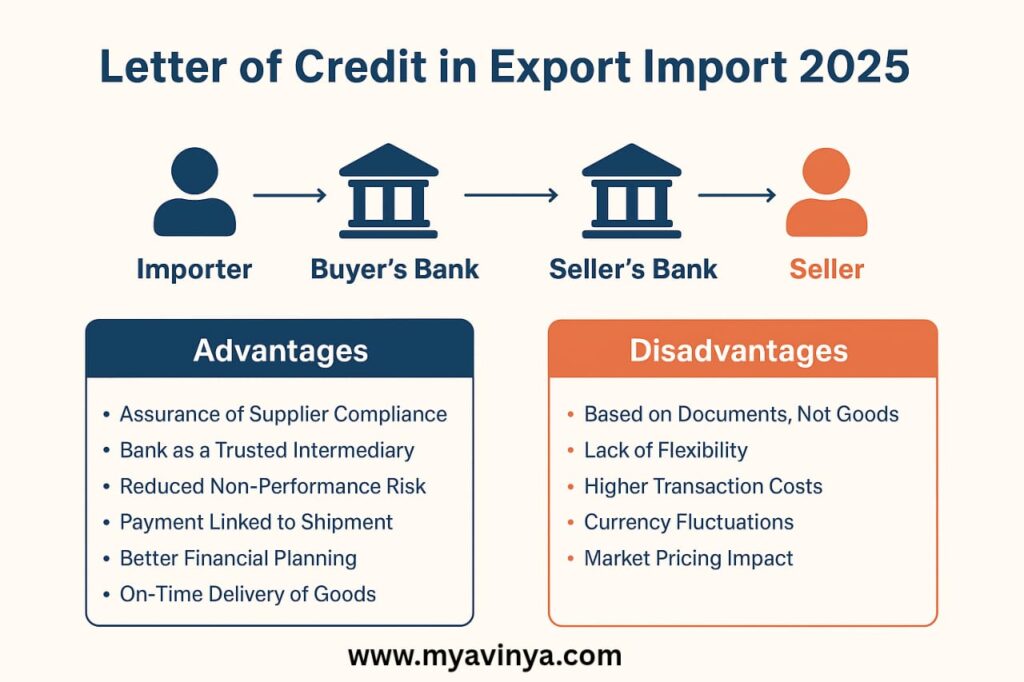In global trade, where buyers and sellers are often separated by thousands of miles and different legal systems, trust is a challenge. That’s where the Letter of Credit (LC) 2025 plays a vital role. For exporters, it acts as a bank-backed guarantee that ensures timely and secure payments, while minimizing credit and operational risks.
This article explains what an LC is, its types, and the key advantages and disadvantages of Letter of Credit (LC) 2025 for exporters.
What is a Letter of Credit (LC) 2025?
A Letter of Credit (LC) 2025 is a written commitment issued by the buyer’s bank, promising to pay the seller (exporter) once the required trade documents are submitted as per the LC terms.
In simple words: if you are an exporter and receive an LC, the buyer’s bank guarantees your payment—provided you comply with the LC conditions.
All LC transactions are governed by UCP 600 guidelines issued by the International Chamber of Commerce (ICC).
Common Types of LC
- Revocable & Irrevocable (Irrevocable LC is the safest and most used)
- Confirmed & Unconfirmed
- Clean & Documentary
- Fixed, Revolving, Transferable, and Back-to-Back

Advantages of Letter of Credit (LC) 2025 for Exporters
1. Minimizes Credit Risk
Exporters often face uncertainty about the buyer’s creditworthiness. With an LC, the bank guarantees payment, reducing the risk of non-payment.
2. Protection Against Disputes
Since LC payments are document-based, buyers cannot delay payments by raising quality disputes after shipment.
3. Security and Reliability
A confirmed LC acts as a firm contract, allowing exporters to plan production, manage finances, and allocate resources confidently.
4. Access to Pre-Shipment Finance
Banks often provide packing credit loans against an LC, ensuring smooth working capital flow and timely order execution.
5. Timely Payment
Exporters receive the full invoice value on the due date, improving cash flow and reducing dependence on buyer goodwill.
6. Fixed & Reliable Business Orders
An irrevocable LC cannot be cancelled without mutual consent, giving exporters stability in production schedules.
7. Efficient Documentation & Delivery
LCs clearly define required documents (bill of lading, invoice, certificate of origin, etc.), helping exporters avoid confusion and ensure smooth delivery.
Disadvantages of Letter of Credit (LC) 2025 for Exporters
1. Strict Compliance Requirement
Banks carefully check every document. Even minor discrepancies (e.g., spelling mistakes or missing dates) can lead to delayed payment or penalties.
2. Additional Costs
LCs involve bank charges, confirmation fees, and handling costs, which may reduce exporter margins.
3. Dependence on Bank Credibility
Exporters must verify the issuing bank’s reputation and financial strength. A weak or fraudulent bank may put payment at risk.
4. Political & Regulatory Risks
Trade sanctions, currency restrictions, or sudden policy changes in the buyer’s country may affect enforceability of the LC.
5. Requirement of Skilled Personnel
Preparing LC-compliant documents needs expertise. Many exporters hire specialists, increasing operational costs.
6. Higher Administrative Burden
Compared to open account or advance payment, LC documentation is more time-consuming and costly.
7. Currency Fluctuation Risks
Since LC payments are often in foreign currency, sudden exchange rate changes can reduce profit margins.
Example in Real Trade
Suppose an Indian textile exporter receives an irrevocable confirmed LC from a European buyer’s bank. Even if the buyer faces financial issues, the exporter is assured of payment once the required documents (like bill of lading, invoice, and packing list) are submitted correctly.
This makes LCs one of the safest payment methods in international trade.
Conclusion
The Letter of Credit (LC) 2025 remains one of the most trusted tools in export-import trade. While it involves strict compliance, additional costs, and currency risks, the advantages—timely payments, reduced credit risk, and access to pre-shipment finance—far outweigh the drawbacks.
Exporters are advised to:
- Use irrevocable confirmed LCs for maximum security.
- Verify the credibility of the issuing bank.
- Invest in skilled staff to handle documentation accurately.
By doing so, exporters can secure payments and grow their international trade business with confidence.
External Resources (DoFollow Links)
- ICC UCP 600 Guidelines – Official Rules for Documentary Credits
- Investopedia: Letter of Credit – Detailed Explanation
Disclaimer
This article is for informational purposes only. Exporters should consult their bank or trade finance advisor before entering into an LC agreement.

